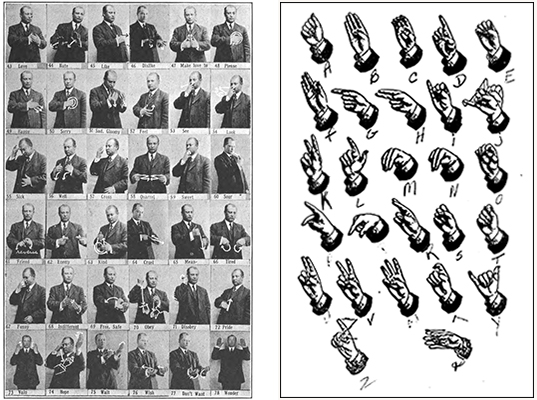Tag: BL Sign Language
American Sign Language
The Languages of Berkeley: An Online Exhibition

The significance of J. Schuyler Long’s The Sign Language; A Manual of Signs, Being A Descriptive Vocabulary of Signs Used by the Deaf of The United States and Canada cannot be separated from the status of Deaf education at the beginning of the 20th century. Beginning in 1880 at the Second International Congress of the Deaf, educators of the Deaf adopted the practice of oralism, which relied solely on speech to teach the Deaf and forcing them to learn skills such as lip reading. Many in the Deaf community viewed this as an attempt to eradicate sign language in an attempt to forcibly assimilate them into the hearing community.[1] As a result of this forced adoption, fewer Deaf instructors were proficient in American Sign Language (ASL), and fewer children were learning the language fluently.
In response, various Deaf educators took the initiative of documenting ASL, taking advantage of these new formats of photography and film to document and preserve the language. J. Schuyler Long, principal at the Iowa School for the Deaf and a graduate of Gallaudet University, developed in 1910 and reprinted in 1918 a handbook of signs used in ASL, incorporating detailed written descriptions of each sign with photographs illustrating each vocabulary term. For example, for the sign “fascinate”, Long describes the motions as such:
Fascinate — Bring the hand up before the face, with fingers extended except the thumb and forefinger which are brought together as if about to grasp something; bring them nearly together and then draw out slowly from the face (giving the idea of drawing the attention out), giving the face an intent or concentrated look.[2]
Long’s manual also firmly states that ASL is indeed a language, with established vocabulary and dialectical variation. This argument helped Deaf activists show that ASL is more than pantomime.
Today, American Sign Language is one of the languages taught at UC Berkeley. Though it was not established as a language course until 2012, students are now able to take ASL to fulfill the language requirement in their degree programs.[3] Even if students are not enrolled in the course, they can still find ways to learn the language, thanks to the evolution of image based media such as YouTube. Thanks to the efforts of educators and activists, students can understand ASL as not just a series of gestures, but as its own complex language.
Contribution by Natalia Estrada,
Reference and Collections Assistant, Social Sciences Division, The Library
Sources consulted:
- Jankowski, K. A. Deaf Empowerment: Emergence, Struggle, and Rhetoric. Washington, D.C: Gallaudet University Press, 1997.
- Long, J. S. The Sign Language; A Manual of Signs, Being A Descriptive Vocabulary of Signs Used by the Deaf of The United States and Canada (2nd ed. reprint). Washington: Gallaudet College, 1969 [©1952].
- Cockrell, Cathy. “ASL Language Courses a Sign of the Times at Berkeley,” Daily Californian (September 20, 2012).
~~~~~~~~~~
Title: The Sign Language; A Manual of Signs, Being A Descriptive Vocabulary of Signs Used by the Deaf of The United States and Canada
Author: Joseph Schuyler Long, 1869-1933.
Imprint: Washington, Gallaudet College, 1969 [©1952].
Edition: 2d ed., rev. and enl.
Language: American Sign Language
Language Family:
Source: HathiTrust Digital Library (University of Michigan)
URL: https://catalog.hathitrust.org/Record/001743786
The Languages of Berkeley is a dynamic online sequential exhibition celebrating the diversity of languages that have advanced research, teaching and learning at the University of California, Berkeley. It is made possible with support from the UC Berkeley Library and is co-sponsored by the Berkeley Language Center (BLC).
Follow The Languages of Berkeley!
Subscribe by email
Contact/Feedback
ucblib.link/languages
![The Languages of Berkeley [fan]](https://update.lib.berkeley.edu/wp-content/uploads/2019/02/fan_languages-450px.jpg)